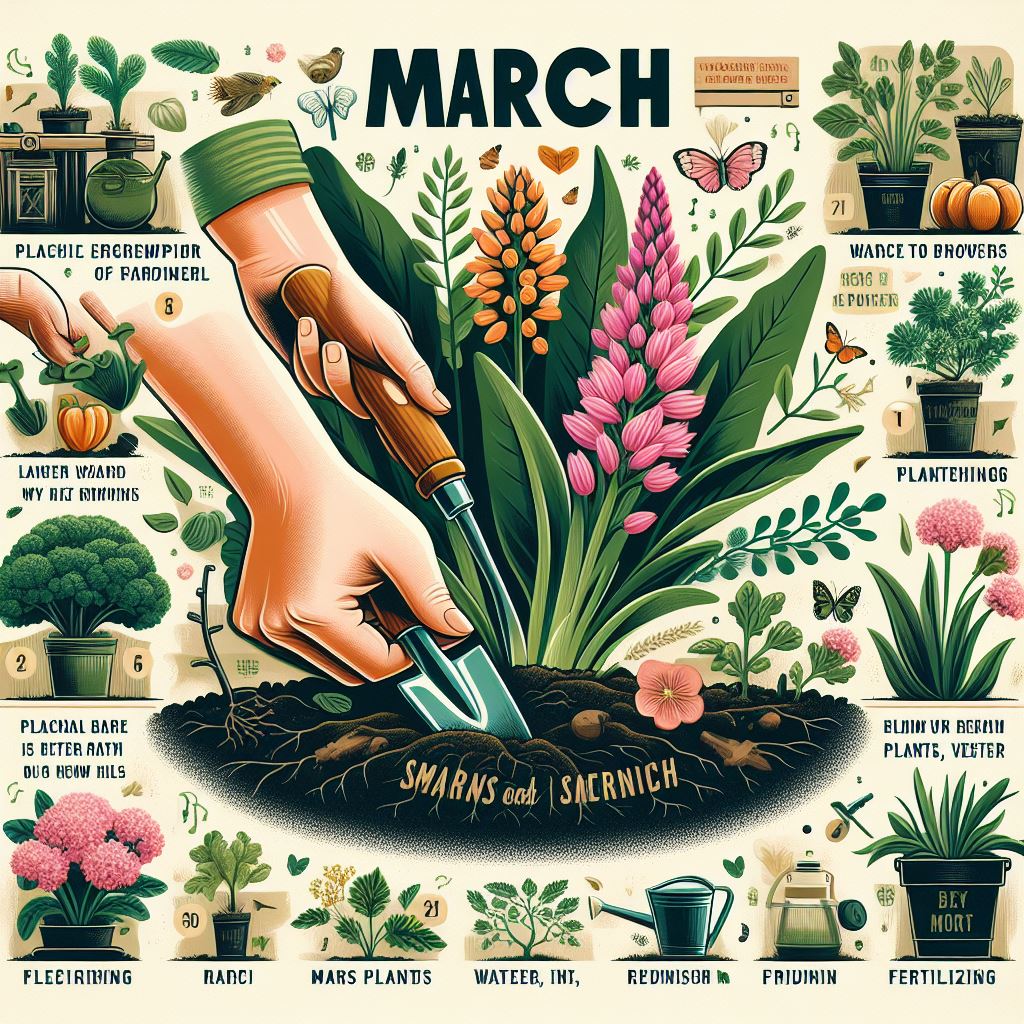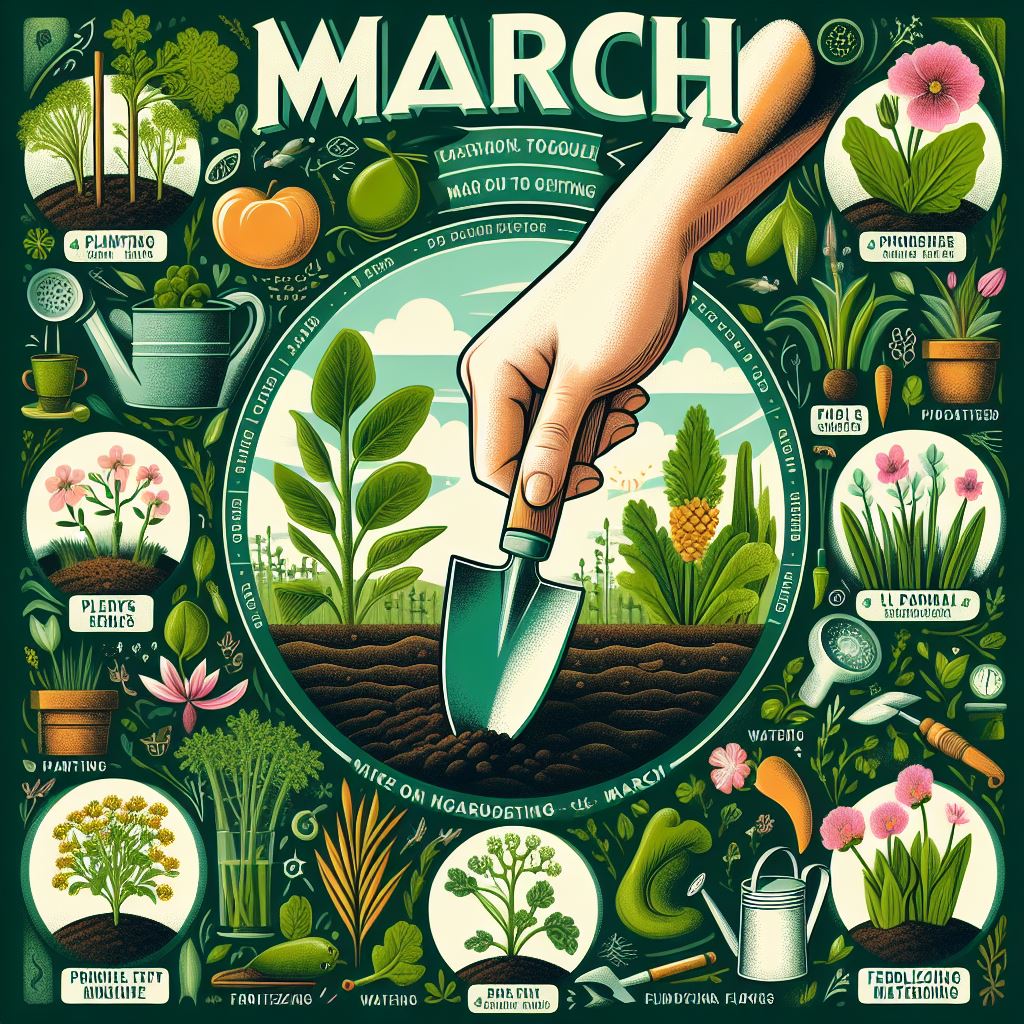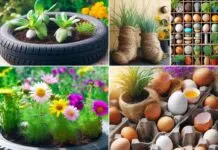Top 22 March Gardening Tips: Cultivating a Flourishing Garden in 2024
As the days lengthen and the promise of spring hangs in the air, seasoned gardeners know that March is a pivotal month. It’s the time when we transition from planning to action, from seed catalogs to soil-stained hands.
Whether you’re a seasoned green thumb or a budding enthusiast, our comprehensive guide will empower you to make the most of this dynamic month. Let’s dive into the Top 22 March Gardening Tips that will set your garden on a path to glory.
1. Soil Preparation: The Foundation of Success
Tip 1: Soil Testing Before you plunge your trowel into the earth, let’s get scientific. Send a soil sample to your local county extension service office for analysis. Armed with the results, you’ll know precisely which nutrients your soil craves. Remember, healthy plants start with healthy soil.
Tip 2: Timing Matters Resist the urge to trample over your garden beds when the soil is soggy. Compaction impedes root growth and drainage. Wait until the soil crumbles easily in your hand before tilling, planting, or even strolling through your garden.
Tip 3: Compost Magic Enrich your soil by incorporating compost. It’s like a nutrient-packed hug for your plants. Dig it in, mix it up, and watch your garden thrive.
2. Regional Insights: Tailoring Tips to Your Locale
Mid-Atlantic Marvels
Tip 4: Hardy Annuals March in the Mid-Atlantic region can be a seesaw of weather. Hardy annuals like pansies can withstand mood swings. Plant them now, but hold off on summer bulbs until the soil warms up.
Tip 5: Perennial Bounty As frost retreats, welcome perennial vegetables and fruits into your garden. Prune rose bushes before they burst forth with new growth.
Midwest Magic
Tip 6: Pruning Wisdom March’s chill lingers in the Midwest. Prune shrubs that bloom on new wood. Trim back ornamental grasses, making room for fresh shoots.
Tip 7: Fruit Tree TLC Spray fruit trees following specific guidelines for each variety. Remove protective burlap from evergreens, revealing their winter resilience.
Northeast Nurturing
Tip 8: Spring Cleaning March sweeps into the Northeast, sometimes gentle, sometimes fierce. Prune flowering shrubs and trim ornamental grasses. Spray fruit trees. Unwrap evergreens from their winter burlap cocoons.
3. Pacific Northwest Paradise
Tip 9: Compost Application The planning phase is over; it’s time to dig in. Spread compost generously across your beds. Plant summer bulbs and peas. Deadhead early bloomers for prolonged flowering.
Tip 10: Rose Reverie Prune rose bushes judiciously, encouraging vigorous growth. Fertilize them for a blooming spectacle.
4. Alaska’s Cold Embrace
Tip 11: Rhubarb Check Alaska clings to winter, but rhubarb may already be poking through. Keep an eye out for these resilient shoots.
5. Pacific Coast Pleasures
Tip 12: Northern California Bliss The garden beckons in Northern California. Apply compost, tuck summer bulbs into the soil, and sow peas. Deadhead spent blooms, and protect apple trees from marauding pests.
6. Early Bloomers: A Symphony of Color
Tip 13: Bulb Planting March is the curtain call for spring bulbs. Tulips, daffodils, and crocuses—these floral virtuosos deserve a standing ovation. Plant them in well-drained soil, ensuring they receive ample sunlight. Remember, bulbs are like a buried treasure; their reward awaits above ground.
Tip 14: Forsythia Fireworks Forsythia, with its golden-yellow blooms, heralds spring’s arrival. Prune it after flowering to maintain its graceful arching form. Bonus: You can force Forsythia branches indoors to bring a burst of sunshine to your windowsill.
7. Pest Patrol: Shielding Your Green Haven
Tip 15: Dormant Oil Spray Before buds swell, apply dormant oil spray to fruit trees and shrubs. This suffocates overwintering pests, thwarting their early-season mischief.
Tip 16: Aphid Vigilance Aphids, those tiny sap-sucking villains, emerge with the warming weather. Keep an eye on tender new growth. If you spot these pests, introduce their natural enemies—ladybugs and lacewings—to restore balance.
8. Veggie Delights: From Plot to Plate
Tip 17: Cool-Season Crops March is a culinary delight. Sow cool-season crops like spinach, lettuce, and radishes. These leafy wonders thrive in the brisk air. Harvest them young for maximum tenderness.
Tip 18: Potato Planting Potatoes, the humble tubers, are ready for their debut. Cut seed potatoes into chunks, each with an “eye.” Plant them in well-amended soil, and watch the magic unfold.
9. Orchards and Berry Patches: Fruitful Endeavors
Tip 19: Pruning Fruit Trees Fruit trees appreciate a well-executed haircut. Remove dead, diseased, or crossing branches. Open up the canopy to sunlight, encouraging robust fruiting.
_Tip 20: Berry Bush Bliss_ Blackberries, raspberries, and blueberries—these berry bushes are your summer allies. Prune them now, shaping their growth and ensuring optimal fruit production.
10. Wildlife Welcome: Creating Biodiversity
Tip 21: Nesting Boxes Invite feathered friends to your garden. Hang nesting boxes for birds like bluebirds, chickadees, and wrens. They’ll repay you with insect control and melodious tunes.
11. Container Gardening: Embrace Versatility in Small Spaces
Maximize your gardening potential with container gardening. Whether you have limited space or simply prefer the flexibility of container gardening, March offers ample opportunities to cultivate an array of plants in pots, hanging baskets, or raised beds.
12. Companion Planting: Harness the Power of Plant Partnerships
Enhance biodiversity and natural pest control by practicing companion planting. Pair compatible plants together to deter pests, attract beneficial insects, and optimize space utilization in your garden beds.
13. Seed Starting: Cultivate Seedlings for a Bountiful Harvest
Kickstart your gardening journey by starting seeds indoors. Invest in quality seed-starting trays and potting mix, and provide optimal growing conditions including warmth, moisture, and adequate light to ensure healthy seedling development.
14. Seasonal Cleanup: Declutter for a Fresh Start
Bid farewell to winter remnants by embarking on a thorough spring cleanup. Remove fallen leaves, debris, and dead plant material to prevent disease spread and create a clean canvas for your gardening endeavors.
15. Soil Testing: Unlock the Secrets of Soil Health
Gain insights into your soil’s fertility levels and pH balance by conducting a soil test. Armed with this information, you can tailor your fertilization and amendment strategies to meet your plants’ specific needs for optimal growth and productivity.
16. Tool Maintenance: Keep Your Tools Sharp and Ready
Ensure your gardening arsenal is in top-notch condition by performing routine maintenance on your tools. Clean, sharpen, and oil your gardening implements to prolong their lifespan and enhance efficiency during gardening tasks.
17. Cold Frame Gardening: Extend the Growing Season
Embrace the versatility of cold frames to extend your gardening season well into the colder months. Utilize these miniature greenhouse structures to protect tender seedlings, harden off plants, and cultivate cold-tolerant vegetables throughout the year.
18. Seasonal Planting Guide: Know Your Planting Zones
Familiarize yourself with your planting zone and its specific climatic conditions to make informed decisions when selecting plants for your garden. Choose varieties that are well-suited to your zone’s temperature and precipitation patterns for optimal success.
19. Integrated Pest Management: Adopt a Holistic Approach
Take a proactive stance against pests and diseases with integrated pest management (IPM) techniques. By combining cultural, mechanical, and biological control methods, you can minimize reliance on chemical pesticides while maintaining a healthy and balanced ecosystem in your garden.
20. Crop Rotation: Prevent Soil Depletion and Disease Buildup
Implement a crop rotation strategy to prevent soil depletion and minimize disease buildup in your garden. Rotate crops annually to disrupt pest and disease cycles and replenish soil nutrients for sustained productivity and fertility.
21. Wildlife Gardening: Create Habitat for Native Species
Transform your garden into a sanctuary for wildlife by incorporating native plants and habitat features. Provide food, shelter, and water sources to attract beneficial pollinators, birds, and other wildlife, fostering a harmonious coexistence between humans and nature.
22. Continuous Learning: Cultivate Your Gardening Expertise
Embark on a lifelong journey of gardening education and discovery. Stay curious, experiment with new techniques and plants, and learn from both successes and failures to continually elevate your gardening prowess.
Conclusion: Cultivate, Nurture, Flourish
As March unfolds, remember that gardening tips for March are a dance with nature. Each tip, each action, contributes to the symphony of growth. So, fellow gardeners, embrace the soil, wield your pruners, and let the promise of spring propel you forward. Your garden awaits—a canvas for your green dreams.












